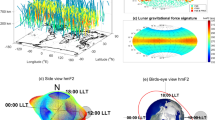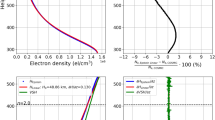Abstract
RECENTLY, D. F. Martyn1 has suggested that electric currents in the D-layer of the ionosphere must make a contribution to the solar and lunar geomagnetic variations roughly equal to that of the E- and F-layers. Since theoretical work on atmospheric tides suggests that the tidal motions tend to increase with height, the electric forces causing the currents can scarcely be greater in the D-layer than in the E- and F-layers. Hence Martyn's suggestion implies that the integral conductivity of the D-layer must be at least as big as that of the E- and F-layers combined. This appears to us to be improbable.
This is a preview of subscription content, access via your institution
Access options
Subscribe to this journal
Receive 51 print issues and online access
$199.00 per year
only $3.90 per issue
Buy this article
- Purchase on SpringerLink
- Instant access to full article PDF
Prices may be subject to local taxes which are calculated during checkout
Similar content being viewed by others
References
Martyn, Nature, 160, 535 (1947).
Cowling, Proc. Roy. Soc., A, 183, 453 (1945).
Massey and Bates, Rep. Prog. Phys., 8, 62 (1942).
Author information
Authors and Affiliations
Rights and permissions
About this article
Cite this article
COWLING, T., BORGER, R. Electrical Conductivity of the Ionospheric D-Layer. Nature 161, 515 (1948). https://doi.org/10.1038/161515a0
Issue date:
DOI: https://doi.org/10.1038/161515a0
This article is cited by
-
Lunar Oscillations in the D-Layer of the Ionosphere
Nature (1949)
-
Electric Conductivity of the Ionospheric D-Region
Nature (1948)



